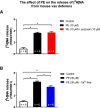The Pharmacological Effects of Phenylephrine are Indirect, Mediated by Noradrenaline Release from the Cytoplasm
- PMID: 35945308
- PMCID: PMC9546997
- DOI: 10.1007/s11064-022-03681-2
The Pharmacological Effects of Phenylephrine are Indirect, Mediated by Noradrenaline Release from the Cytoplasm
Abstract
Phenylephrine (PE) is a canonical α1-adrenoceptor-selective agonist. However, unexpected effects of PE have been observed in preclinical and clinical studies, that cannot be easily explained by its actions on α1-adrenoceptors. The probability of the involvement of α2- and β-adrenoceptors in the effect of PE has been raised. In addition, our earlier study observed that PE released noradrenaline (NA) in a [Ca2+]o-independent manner. To elucidate this issue, we have investigated the effects of PE on [3H]NA release and α1-mediated smooth muscle contractions in the mouse vas deferens (MVD) as ex vivo preparation. The release experiments were designed to assess the effects of PE at the presynaptic terminal, whereas smooth muscle isometric contractions in response to electrical field stimulation were used to measure PE effect postsynaptically. Our results show that PE at concentrations between 0.3 and 30 µM significantly enhanced the resting release of [3H]NA in a [Ca2+]o-independent manner. In addition, prazosin did not affect the release of NA evoked by PE. On the contrary, PE-evoked smooth muscle contractions were inhibited by prazosin administration indicating the α1-adrenoceptor-mediated effect. When the function of the NA transporter (NAT) was attenuated with nisoxetine, PE failed to release NA and the contractions were reduced by approximately 88%. The remaining part proved to be prazosin-sensitive. The present work supports the substantial indirect effect of PE which relays on the cytoplasmic release of NA, which might explain the reported side effects for PE.
Keywords: Cytoplasmic origin; Indirect action; Noradrenaline release; Noradrenaline transporter; Phenylephrine; α1-Adrenoceptor.
© 2022. The Author(s).
Conflict of interest statement
The authors declare no conflicts of interest.
Figures









Similar articles
-
Investigation of the subtypes of alpha 1-adrenoceptor mediating contractions of rat aorta, vas deferens and spleen.Br J Pharmacol. 1993 May;109(1):80-7. doi: 10.1111/j.1476-5381.1993.tb13534.x. Br J Pharmacol. 1993. PMID: 8098642 Free PMC article.
-
Evidence for a functional alpha 1A- (alpha 1C-) adrenoceptor mediating contraction of the rat epididymal vas deferens and an alpha 1B-adrenoceptor mediating contraction of the rat spleen.Br J Pharmacol. 1995 Jun;115(3):467-75. doi: 10.1111/j.1476-5381.1995.tb16356.x. Br J Pharmacol. 1995. PMID: 7582458 Free PMC article.
-
Effect of adrenoceptor agonists on striated muscle strips of the canine oesophagus.Br J Pharmacol. 1993 Sep;110(1):297-302. doi: 10.1111/j.1476-5381.1993.tb13808.x. Br J Pharmacol. 1993. PMID: 8106105 Free PMC article.
-
Prejunctional facilitatory alpha 1-adrenoceptors in the rat urinary bladder.Br J Pharmacol. 1995 Apr;114(8):1710-6. doi: 10.1111/j.1476-5381.1995.tb14961.x. Br J Pharmacol. 1995. PMID: 7599939 Free PMC article.
-
Modulation of voiding and storage reflexes by activation of alpha1-adrenoceptors.Eur Urol. 1999;36 Suppl 1:68-73. doi: 10.1159/000052324. Eur Urol. 1999. PMID: 10393477 Review.
Cited by
-
Optimizing anesthesia strategies to NSCLC patients in VATS procedures: Insights from drug requirements and patient recovery patterns.Open Med (Wars). 2024 Jun 3;19(1):20240961. doi: 10.1515/med-2024-0961. eCollection 2024. Open Med (Wars). 2024. PMID: 38841176 Free PMC article.
-
Activation of IP3R in atrial cardiomyocytes leads to generation of cytosolic cAMP.Am J Physiol Heart Circ Physiol. 2024 Oct 1;327(4):H830-H846. doi: 10.1152/ajpheart.00152.2024. Epub 2024 Aug 2. Am J Physiol Heart Circ Physiol. 2024. PMID: 39093001 Free PMC article.
-
Functional characterization of the α1-adrenoceptor in adult male rat locus coeruleus neurons ex vivo.Front Pharmacol. 2025 Aug 21;16:1626019. doi: 10.3389/fphar.2025.1626019. eCollection 2025. Front Pharmacol. 2025. PMID: 40918509 Free PMC article.
References
-
- Ahlquist RP. A study of the adrenotropic receptors. Am J Physiol. 1948;153(3):586–600. - PubMed
-
- Minneman KP, et al. Selectivity of agonists for cloned alpha 1-adrenergic receptor subtypes. Mol Pharmacol. 1994;46(5):929–936. - PubMed
-
- Hieble JP, et al. International Union of Pharmacology. X. Recommendation for nomenclature of alpha 1-adrenoceptors: consensus update. Pharmacol Rev. 1995;47(2):267–470. - PubMed
-
- Vizi ES. Compounds acting on alpha 1- and alpha 2- adrenoceptors: agonists and antagonists. Med Res Rev. 1986;6(4):431–449. - PubMed
-
- Goodman & Gilman’s . The pharmacological basis of therapeutics. 13. New York: McGraw Hill; 2017.
MeSH terms
Substances
Grants and funding
LinkOut - more resources
Full Text Sources
Miscellaneous

